Influence of Shock Wave on Loss and Breakdown of Tip-Leakage Vortex in Turbine Rotor with Varying Backpressure
Abstract
:1. Introduction
2. Numerical Modeling
2.1. Computational Domain and Boundary Conditions
2.2. Solution Method and Computational Grid
2.3. Validation of the Numerical Method
3. Result and Discussion
3.1. Analysis of the Leakage Vortex Loss
3.1.1. Analysis Method
3.1.2. Loss in the Leakage Vortex
3.2. Flow within the Leakage Vortex
3.2.1. Interaction between Shock Wave and Tip-Leakage Vortex
3.2.2. Effect of the Shock Wave on the Leakage Vortex
3.3. Breakdown of the Leakage Vortex Core
3.3.1. Leakage Vortex Breakdown
3.3.2. Vortex Structure
3.3.3. Shock Wave on the Breakdown of the Leakage Vortex
4. Conclusions
Author Contributions
Funding
Institutional Review Board Statement
Informed Consent Statement
Data Availability Statement
Acknowledgments
Conflicts of Interest
Nomenclature
| C | Chord length |
| Cx | Axial chord length |
| Y | local total-pressure loss |
| Ypk | Peak loss of the leakage vortex |
| Yp | Blade profile loss |
| Tip-leakage vortex loss | |
| Total loss of the blade passage, | |
| Averaged relative total pressure at the rotor inlet | |
| Local relative total pressure | |
| Ma2 | Exit Mach number |
| Back pressure of turbine | |
| Lowest spanwise bound of leakage vortex | |
| Lowest spanwise bound of leakage vortex | |
| Spanwise scale of the leakage vortex, | |
| Physical angular velocity of the rotor | |
| Vorticity | |
| Relative vorticity, | |
| Incident angle of the leakage vortex axis relative to the normal direction of shock wave | |
| Emergence angle of the flow behind the shock wave | |
| y+ | Non-dimensional distance |
| RANS | Reynolds-Averaged Navier-Stokes |
| SST | Shear Stress Transport |
| HPT | High-Pressure Turbine |
| 3D | Three-Dimensional |
| 2D | Two-Dimensional |
| PS | Pressure Side |
| SS | Suction Side |
| LE | Leading Edge |
| TE | Trailing Edge |
References
- Sun, D.W. The Investigation of Secondary Flow Mechanism, Loss Model and Control Technique for High Pressure Turbine; Northwestern Polytechnical University: Xi’an, China, 2009. [Google Scholar]
- Denton, J.D. The 1993 IGTI Scholar Lecture: Loss Mechanisms in Turbomachines. J. Turbomach. 1993, 115, 621–656. [Google Scholar] [CrossRef]
- Booth, T.C. Importance of Tip Clearance Flows in Turbine Design. In Tip Clearance Effects in Axial Turbomachines; Von Karman Institute for Fluid Dynamics: Sint-Genesius-Rode, Belgium, 1985; pp. 1–34. [Google Scholar]
- Pullan, G.; Denton, J. Curtis, Éric Improving the Performance of a Turbine with Low Aspect Ratio Stators by Aft-Loading. J. Turbomach. 2004, 128, 492–499. [Google Scholar] [CrossRef]
- Zou, Z.; Wang, S.; Liu, H.; Zhang, W. Axial Turbine Aerodynamics for Aero-Engines: Flow Analysis and Aerodynamics Design, 1st ed.; Springer Nature: Singapore, 2018. [Google Scholar]
- Bindon, J.P. The Measurement and Formation of Tip Clearance Loss. J. Turbomach. 1989, 111, 257–263. [Google Scholar] [CrossRef]
- Li, W.; Qiao, W.Y.; Xu, K.F. Unsteadiness of tip clearance vortex in turbine. J. Propuls. Technol. 2008, 29, 204–207. [Google Scholar]
- Huang, A.C.; Greitzer, E.M.; Tan, C.S.; Clemens, E.F.; Gegg, S.G.; Turner, E.R. Blade Loading Effects on Axial Tur-bine Tip Leakage Vortex Dynamics and Loss. In Proceedings of ASME Turbo Expo 2012; ASME: Copenhagen, Denmark, 2012. [Google Scholar]
- Huang, A. Loss Mechanisms in Turbine Tip Clearance Flows; Massachusetts Institute of Technology: Boston, MA, USA, 2011. [Google Scholar]
- Gao, J.; Zheng, Q.; Xu, T.; Zhang, Z. Effect of Tip Leakage Vortex Breakdown on Losses in Axial Turbines. Chin. J. Aeronaut. 2014, 35, 1257–1264. [Google Scholar]
- Gao, J.; Zheng, Q.; Liu, Y.; Dong, P. Effects of blade rotation on axial turbine tip leakage vortex breakdown and loss. Proc. Inst. Mech. Eng. Part G J. Aerosp. Eng. 2017, 231, 1634–1649. [Google Scholar] [CrossRef]
- Hou, W.T.; Qiao, W.Y.; Luo, H.L. Shock-Wave/Boundary-Layer Interaction in a Transonic Turbine Cascade. Proc. Inst. Mech. Eng. Part G J. Aerosp. Eng. 2010, 225, 77–85. [Google Scholar] [CrossRef]
- Babinsky, H.; Harvey, J.K. Shock Wave-Boundary-Layer Interactions, 1st ed.; Cambridge University Press: New York, NY, USA, 2011. [Google Scholar]
- Giles, M.B. Stator/rotor interaction in a transonic turbine. J. Propuls. Power 1990, 6, 621–627. [Google Scholar] [CrossRef]
- Paniagua, G.; Yasa, T.; De La Loma, A.; Castillon, L.; Coton, T. Unsteady Strong Shock Interactions in a Transonic Turbine: Experimental and Numerical Analysis. J. Propuls. Power 2008, 24, 722–731. [Google Scholar] [CrossRef]
- Puterbaugh, S.L.; Brendel, M. Tip Clearance Flow-Shock Interaction in a Transonic Compressor Rotor. J. Propuls. Power 1997, 13, 24–30. [Google Scholar] [CrossRef]
- Yamada, K.; Furukawa, M.; Nakano, T.; Inoue, M.; Funazaki, K. Unsteady Three-Dimensional Flow Phenomena Due to Breakdown of Tip Leakage Vortex in a Transonic Axial Compressor Rotor; ASME International: New York, NY, USA, 2004; pp. 515–526. [Google Scholar]
- Zhang, Y. Investigation of Endwall Flow Behaviour and Its Control Strategies in Highly-Loaded Compressor; North-West Polytechnical University: Xi’an, China, 2010. [Google Scholar]
- Kaneko, M.; Tsujita, H. Numerical investigation of influence of tip leakage flow on secondary flow in transonic cen-trifugal compressor at design condition. J. Therm. Sci. 2015, 24, 117–122. [Google Scholar] [CrossRef]
- Timko, L.P. Energy Efficient Engine: High Pressure Turbine Component test Performance Report; General Electric Company, Aircraft Engine Group: Cincinnati, OH, USA, 1984. [Google Scholar]
- Balasubramanian, R.; Barrows, S.; Chen, J.P. Investigation of shear-stress transport turbulence model for tur-bomachinery applications. In Proceedings of the 46th AIAA Aerospace Sciences Meeting and Exhibit, Reno, NV, USA, 7–10 January 2008; Volume 566. [Google Scholar]
- Krishnababu, S.; Newton, P.J.; Dawes, W.N.; Lock, G.D.; Hodson, H.P.; Hannis, J.; Whitney, C. Aero-Thermal Inves-tigations of Tip Leakage Flow in Axial Flow Turbines-Part I: Effect of Tip Geometry and Tip Clearance Gap. In Proceedings of the GT2007, ASME Turbo Expo 2007: Power for Land, Sea and Air, Montreal, QC, Canada, 14–17 May 2007. [Google Scholar]
- Sell, M.; Treiber, M.; Casciaro, C.; Gyarmathy, G. Tip-clearance-affected flow fields in a turbine blade row. Proc. Inst. Mech. Eng. Part A J. Power Energy 1999, 213, 309–318. [Google Scholar] [CrossRef]
- Zhao, L.; Qiao, W.-Y.; Mu, Z.-Q.; Chen, P.-P. Tip Clearance Effects on Unsteady Behavior of the Tip Leakage Vortex and Stator/Rotor Interaction Tonal Noise. In Proceedings of the ASME Turbo Expo 2012: Turbine Technical Conference and Ex-position. Volume 8: Turbomachinery, Parts A, B, and C, Copenhagen, Denmark, 11–15 June 2012; pp. 1735–1744. [Google Scholar] [CrossRef]
- Behr, T. Control of Rotor Tip Leakage and Secondary Flow by Casing Air Injection in Unshrouded Axial Turbines; ETH Zürich: Zürich, Switzerland, 2007. [Google Scholar]
- Tang, H.; Liu, S.; Luo, H.; Hou, W. Unsteady Effects of Profiled Endwalls on a 1.5 Stage Axial Turbine. Volume 7B Struct. Dyn. 2015, 15. [Google Scholar] [CrossRef]
- Wei, Z.J. A Study on the Endwall Unsteady Flow and Loss of Highly-Loaded Turbine; Northwestern Polytechnical University: Xi’an, China, 2016. [Google Scholar]
- Dunker, R. Advances in Engine Technology, 1st ed.; John. Wiley& Sons Ltd.: Hoboken, NJ, USA, 1995. [Google Scholar]
- Hergt, A. Über Grenzschichtbeeinflussende Maßnahmen in den Randzonen von Verdichtergittern; Der Technischen Universität Berlin: Berlin, Germany, 2011. [Google Scholar]
- Wei, Z.; Qiao, W.; Duan, W.; Liu, J. Influence of scrapping effect on formation of casing passage vortex in turbine rotor. J. Aerosp. Power 2018, 33, 1695–1704. [Google Scholar]
- Furukawa, M.; Inoue, M.; Saiki, K.; Yamada, K. The Role of Tip Leakage Vortex Breakdown in Compressor Rotor Aerodynamics. J. Turbomach. 1999, 121, 469–480. [Google Scholar] [CrossRef]
- Schlechtriem, S.; Lötzerich, M. Breakdown of Tip Leakage Vortices in Compressors at Flow Conditions Close to Stall. In Proceedings of the ASME 1997 International Gas Turbine and Aeroengine Congress and Exhibition. Volume 1: Aircraft Engine; Marine; Turbomachinery; Microturbines and Small Turbomachinery, Orlando, FL, USA, 2–5 June 1997. [Google Scholar] [CrossRef] [Green Version]
- Hiejima, T. Criterion for vortex breakdown on shock wave and streamwise vortex interactions. Phys. Rev. E 2014, 89, 053017. [Google Scholar] [CrossRef] [PubMed]
- Qadri, U.A.; Mistry, D.; Juniper, M.P. Structural sensitivity of spiral vortex breakdown. J. Fluid Mech. 2013, 720, 558–581. [Google Scholar] [CrossRef] [Green Version]
- Cowles, B.A. High cycle fatigue in aircraft gas turbines—An industry perspective. Int. J. Fract. 1996, 80, 147–163. [Google Scholar] [CrossRef]
- Alekseenko, S.V.; Kuibin, P.A.; Okulov, V.L. Theory of Concentrated Vortices: An Introduction; Springer-Verlag: Heidelberg, Germany, 2007. [Google Scholar]
- Wu, J.-Z.; Ma, H.-Y.; Zhou, M.-D. Vorticity and Vortex Dynamics; Springer Science and Business Media LLC: Heidelberg, Germany, 2006. [Google Scholar]
- Rankine, W.J.M. Manual of Applied Mechanics; C. Griffen Co.: London, UK, 1858. [Google Scholar]
- Anderson, J.D. Fundamentals of Aerodynamics-6ed, 6th ed.; Mc Graw Hill Education: New York, NY, USA, 2017. [Google Scholar]
- Greitzer, E.M.; Tan, C.S.; Graf, M.B. Internal Flow: Concepts and Applications, 1st ed.; Cambridge University Press: New York, NY, USA, 2004. [Google Scholar]
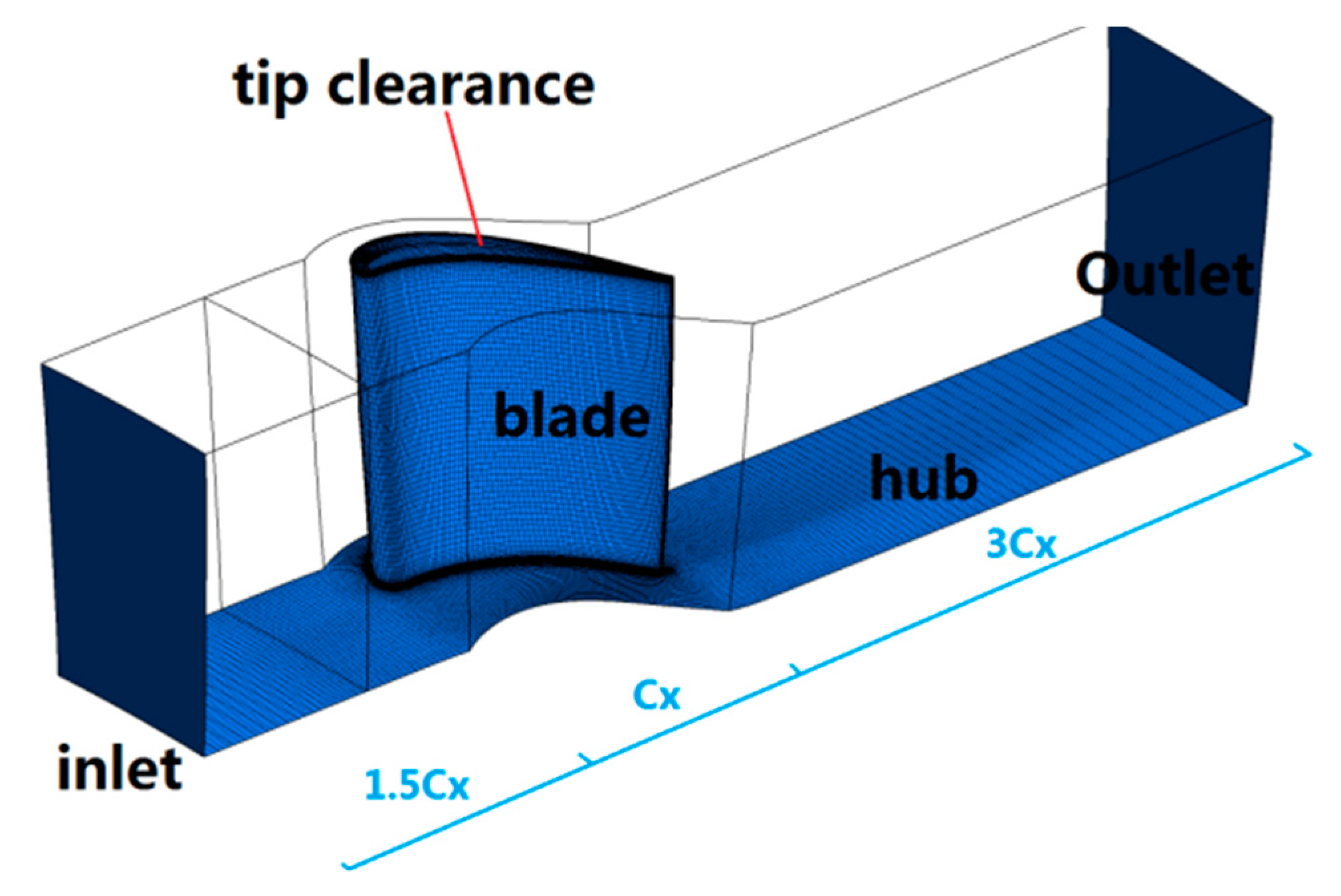
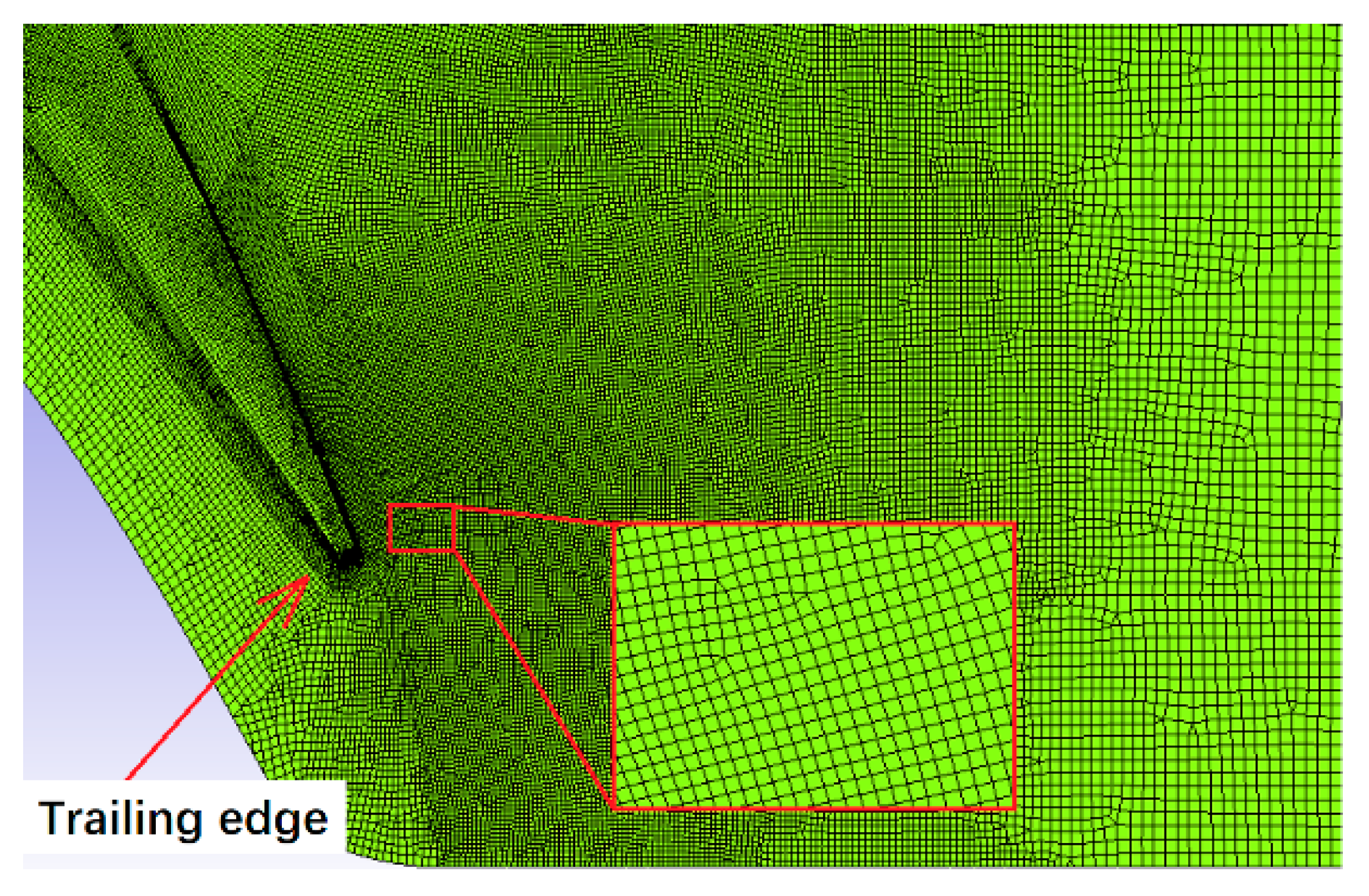
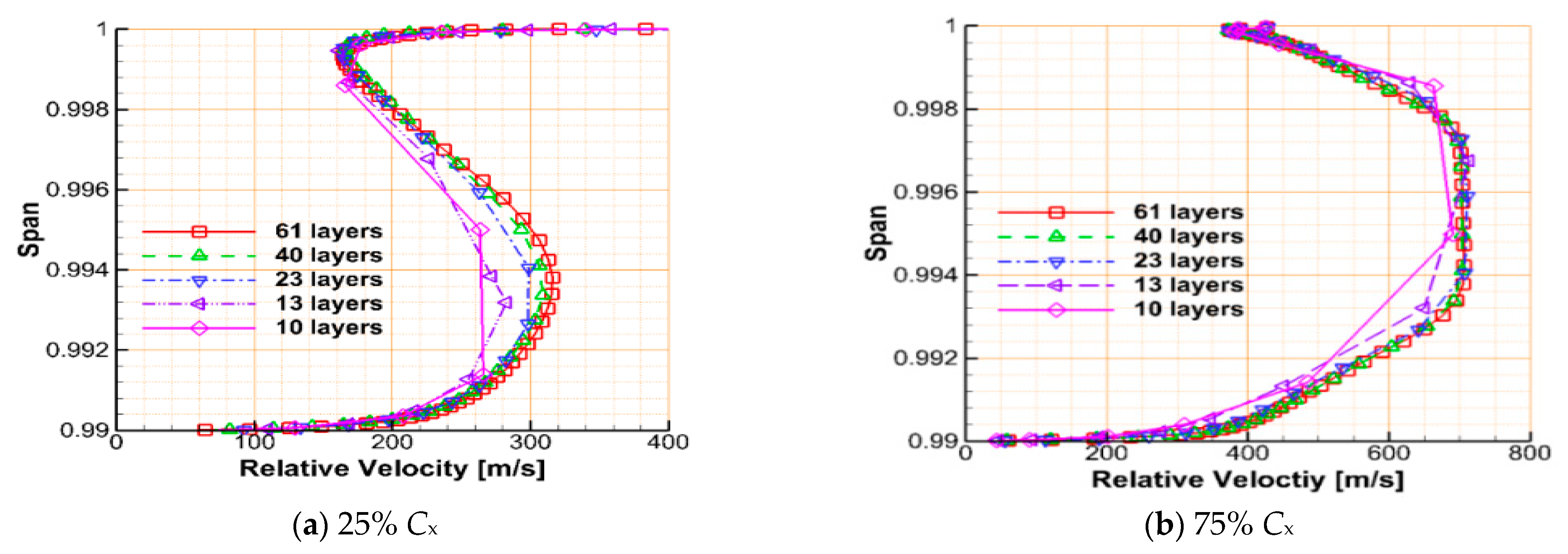

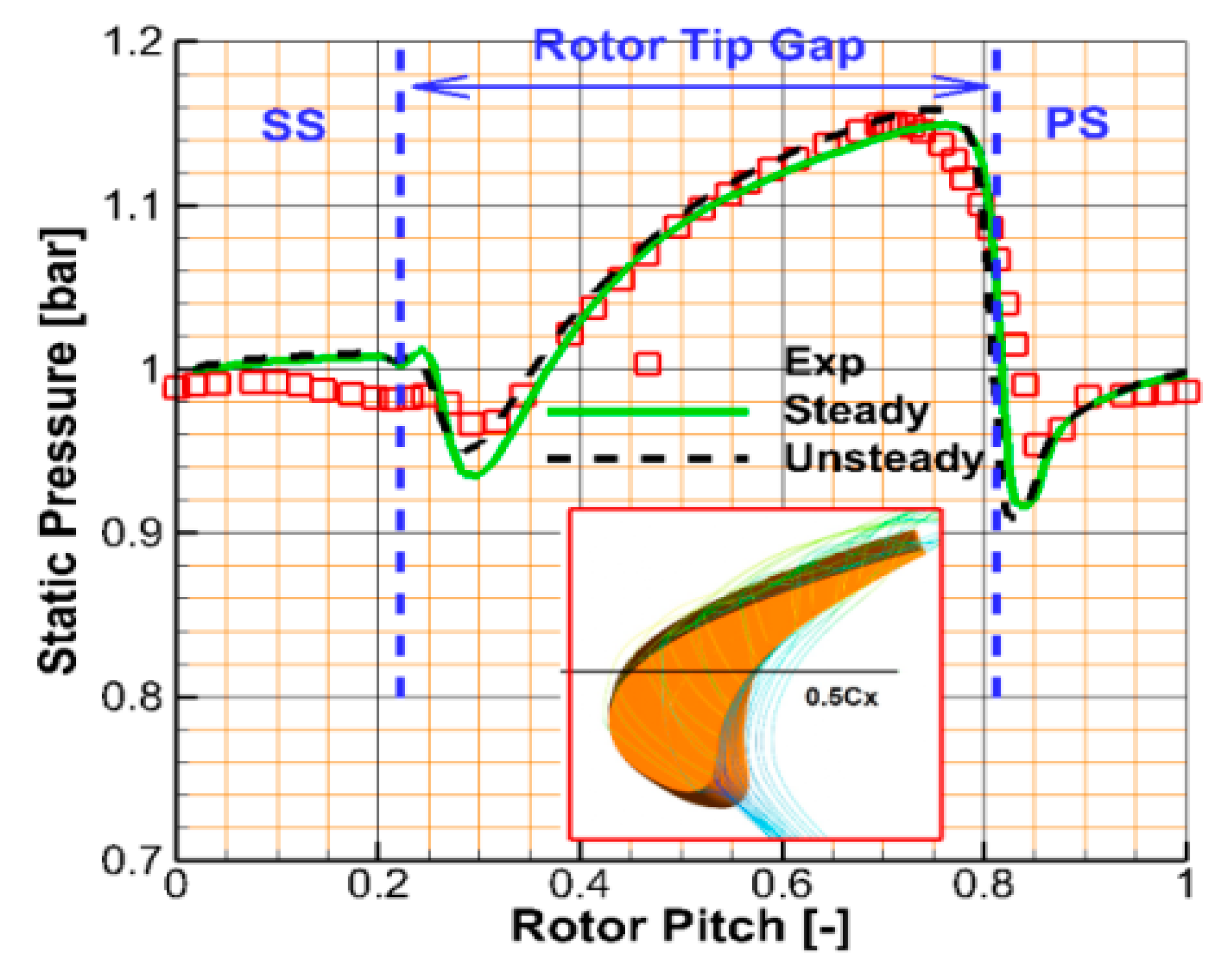
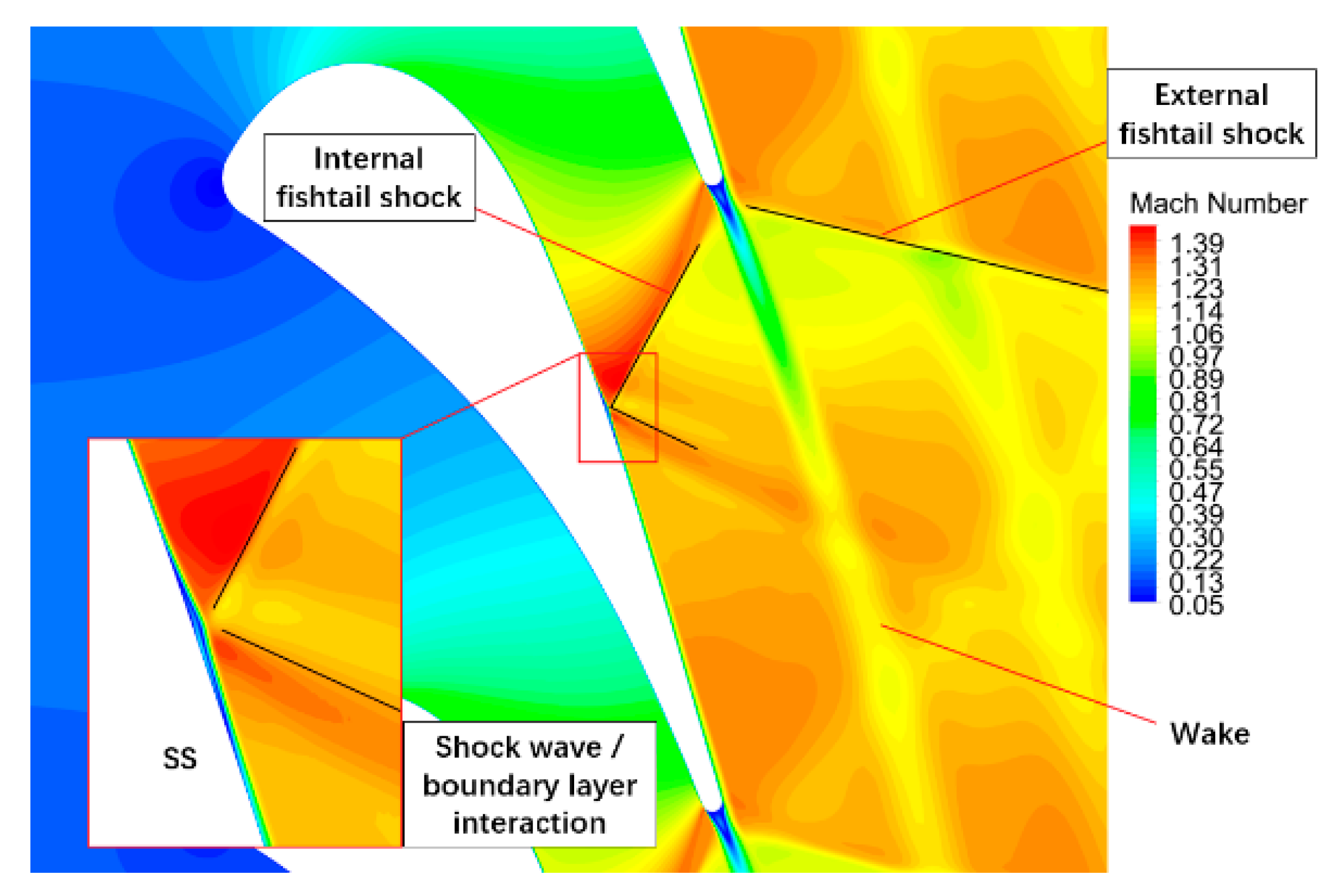
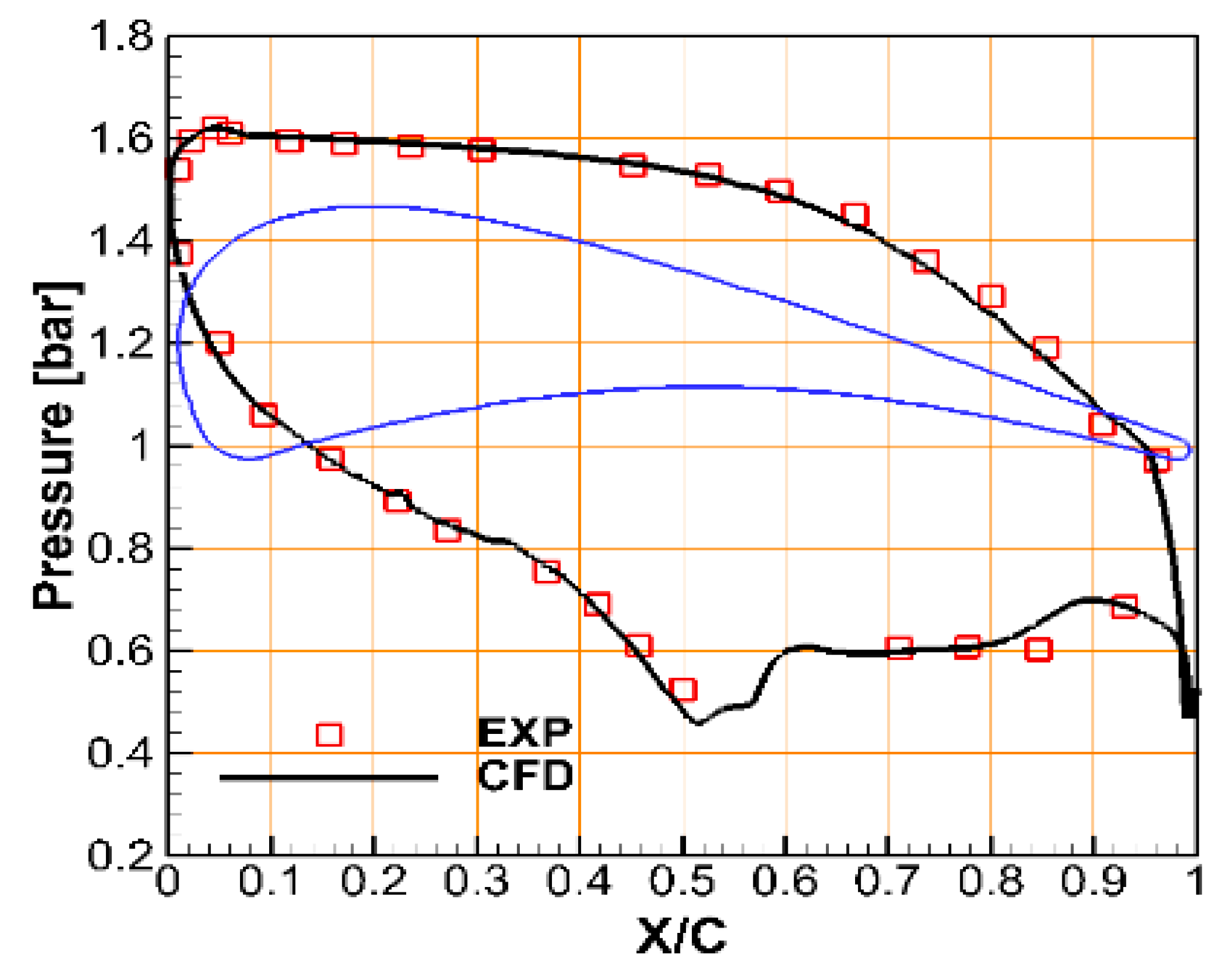

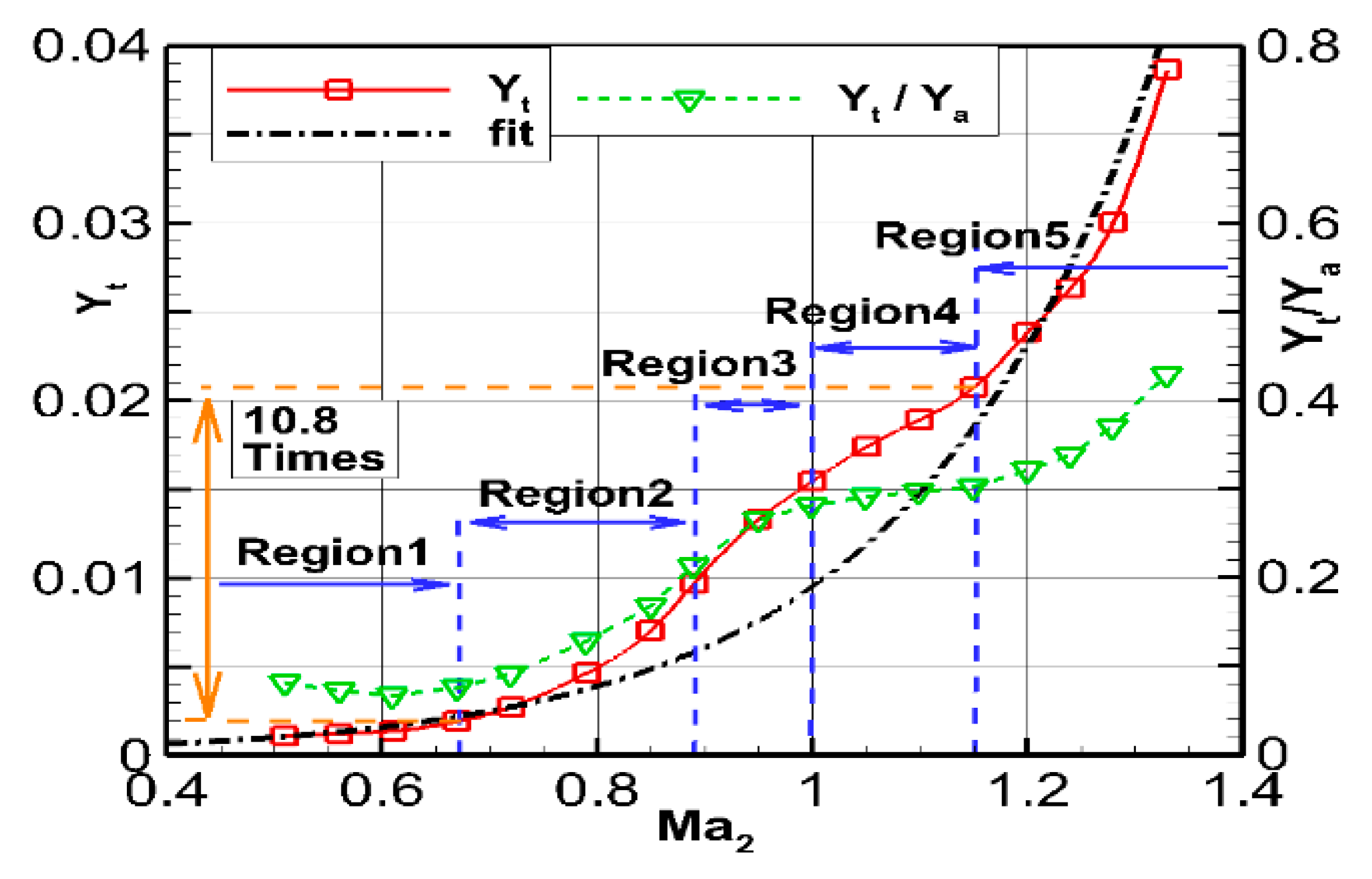
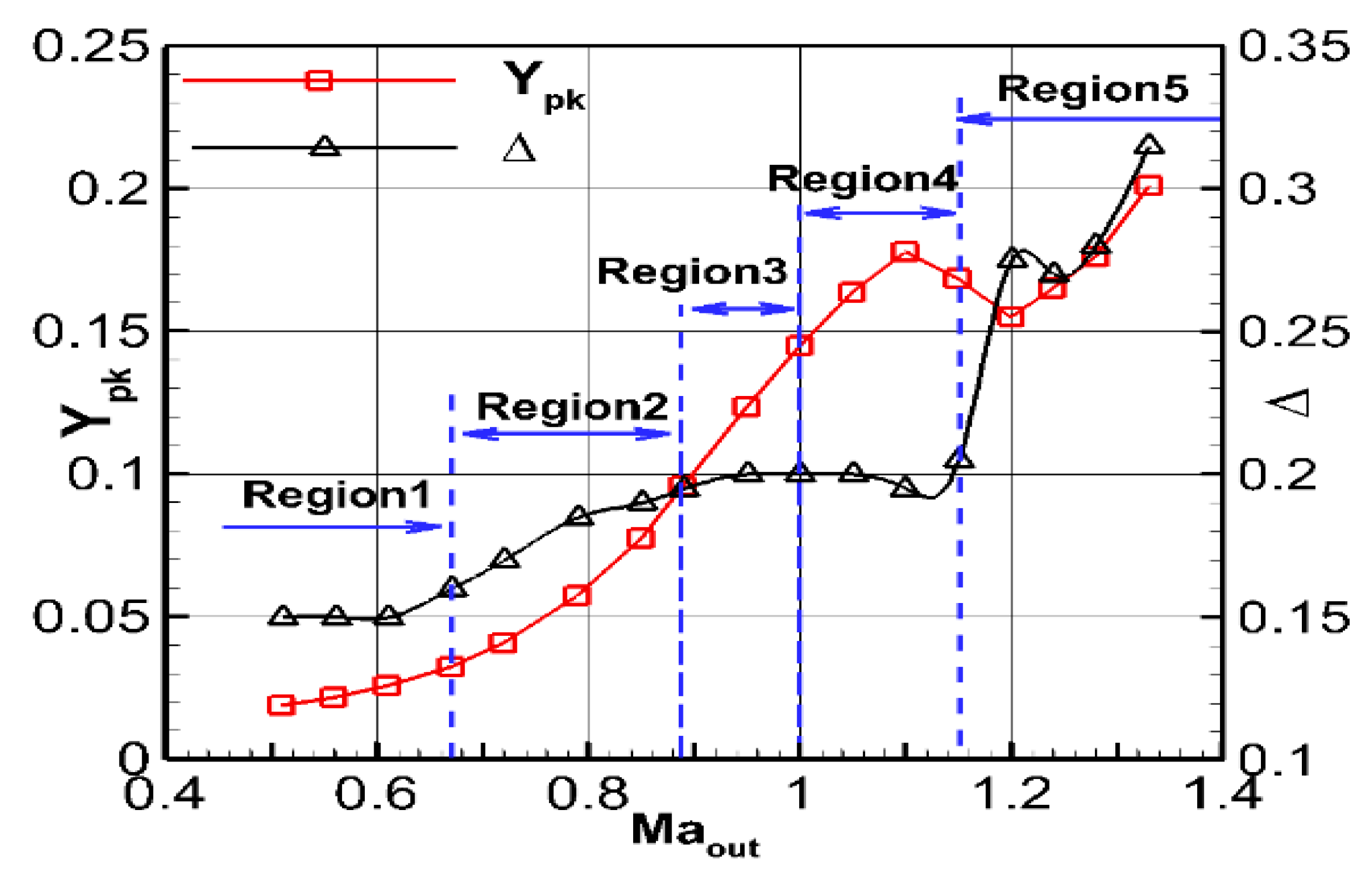
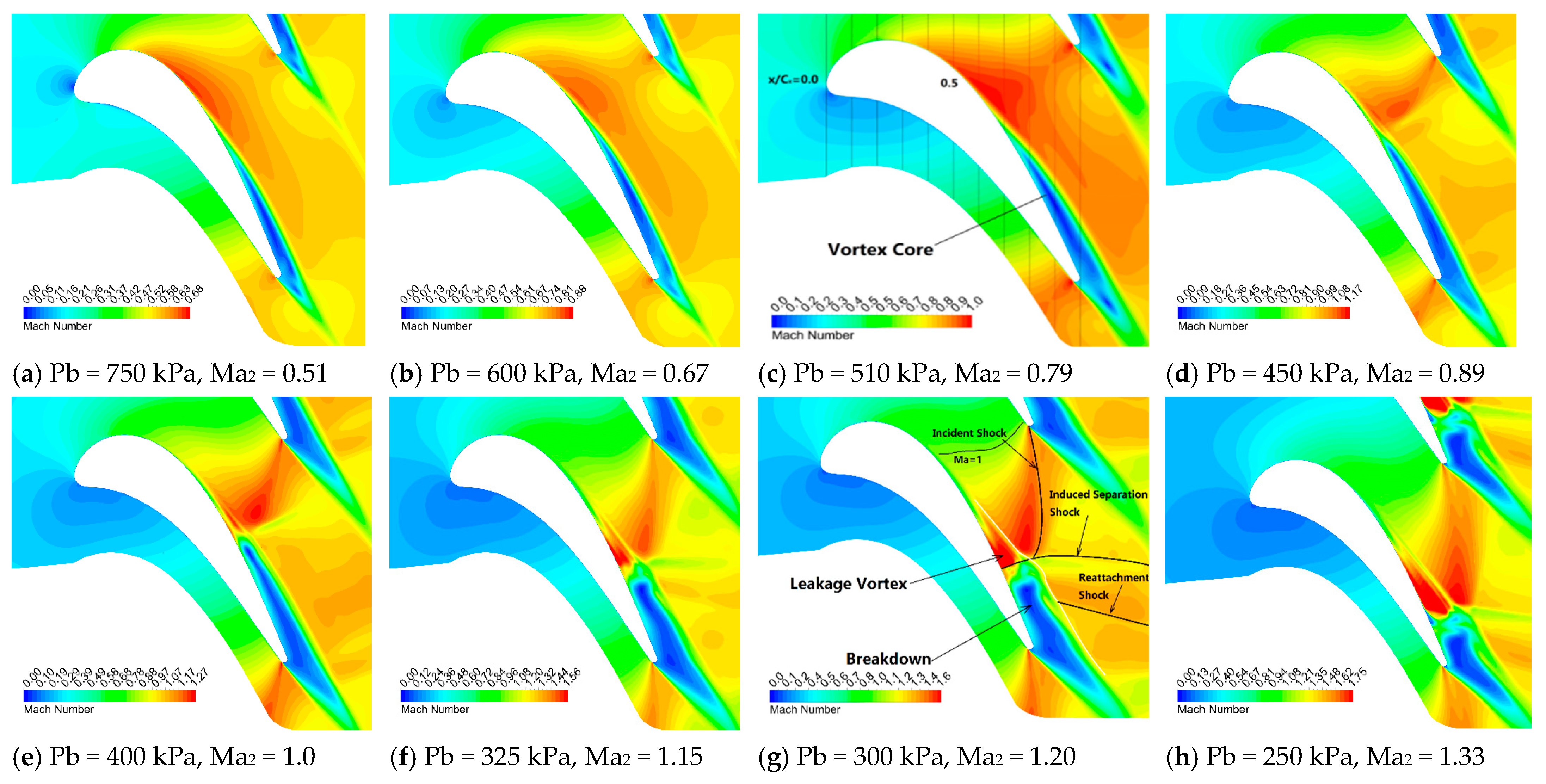


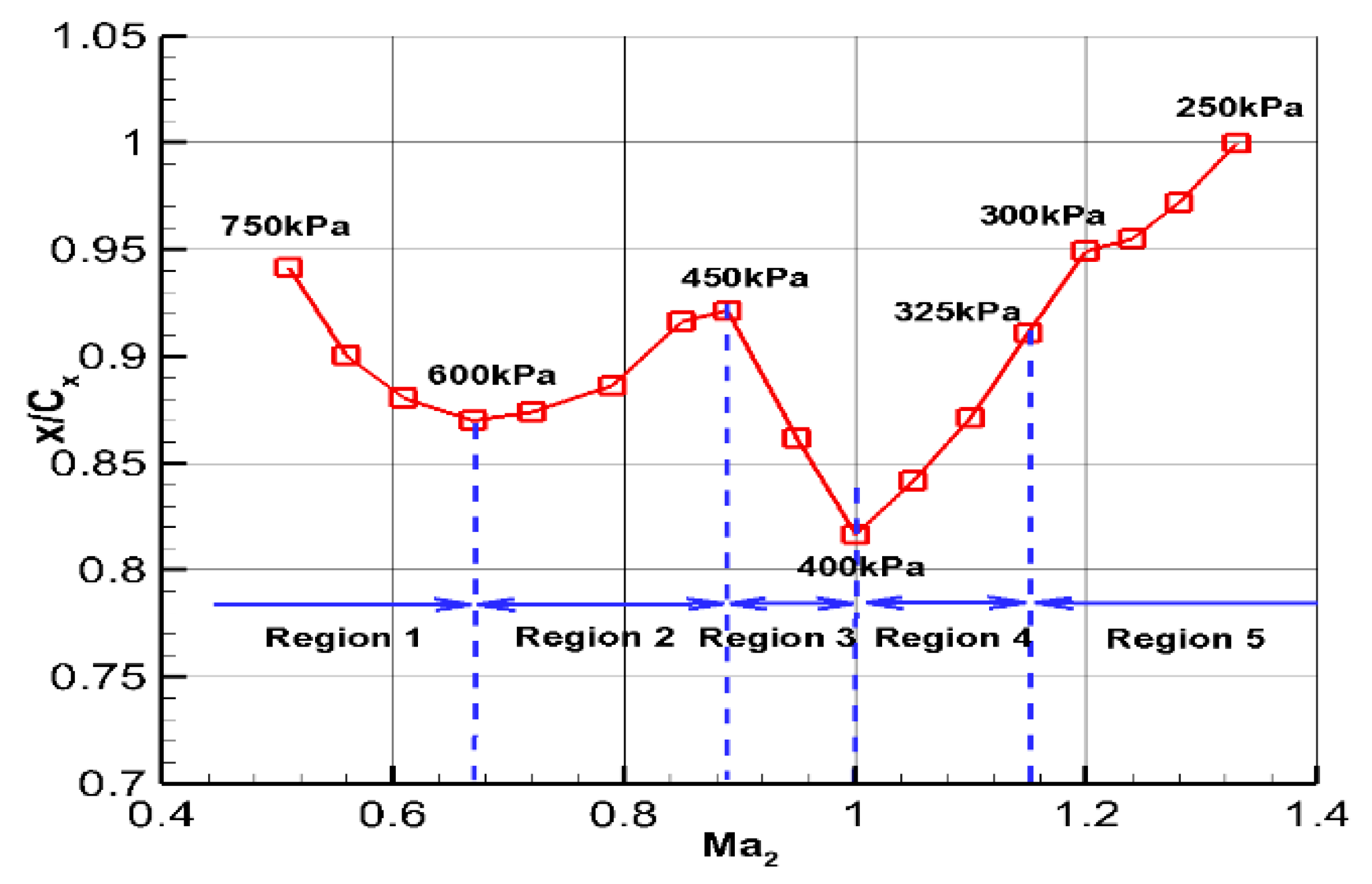
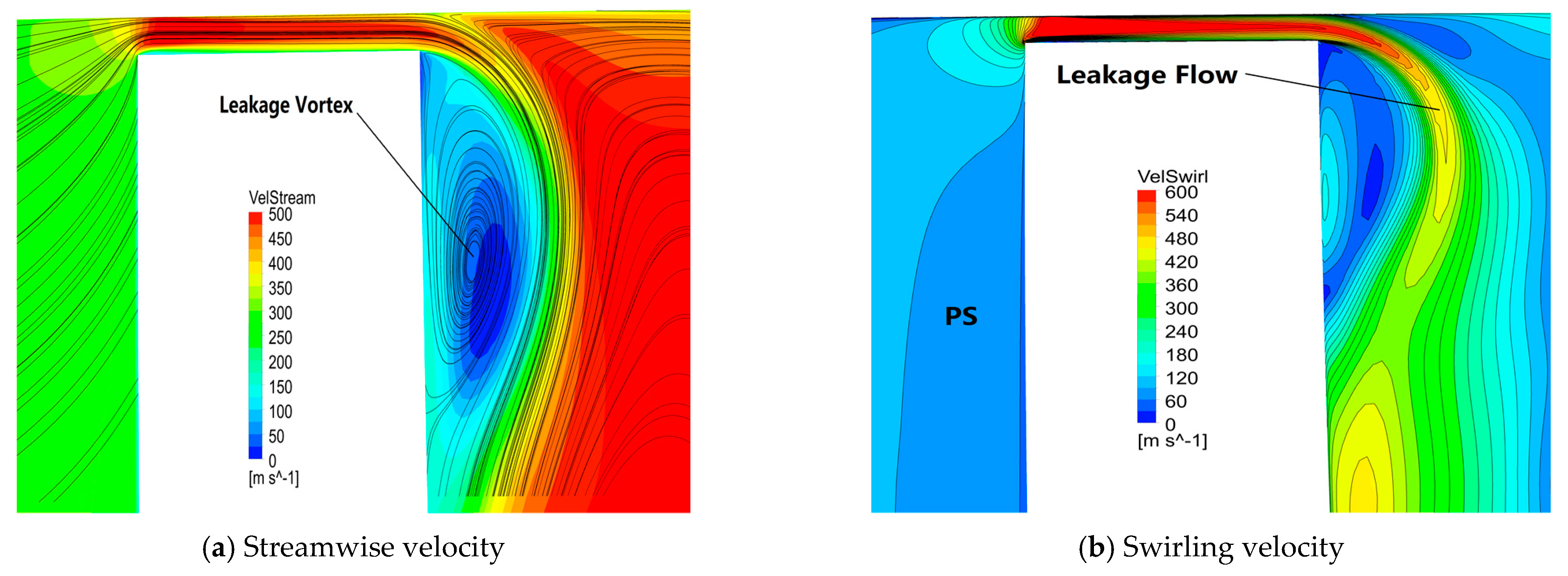
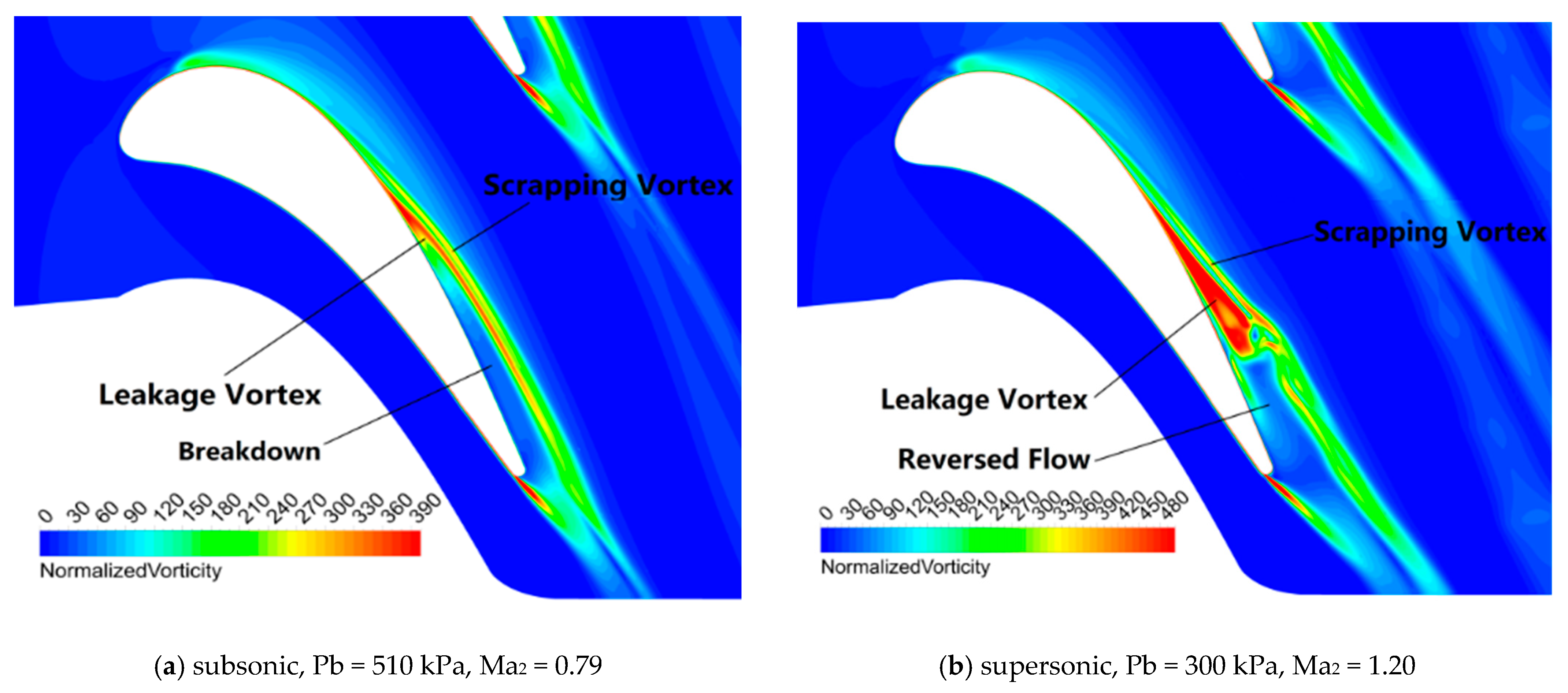
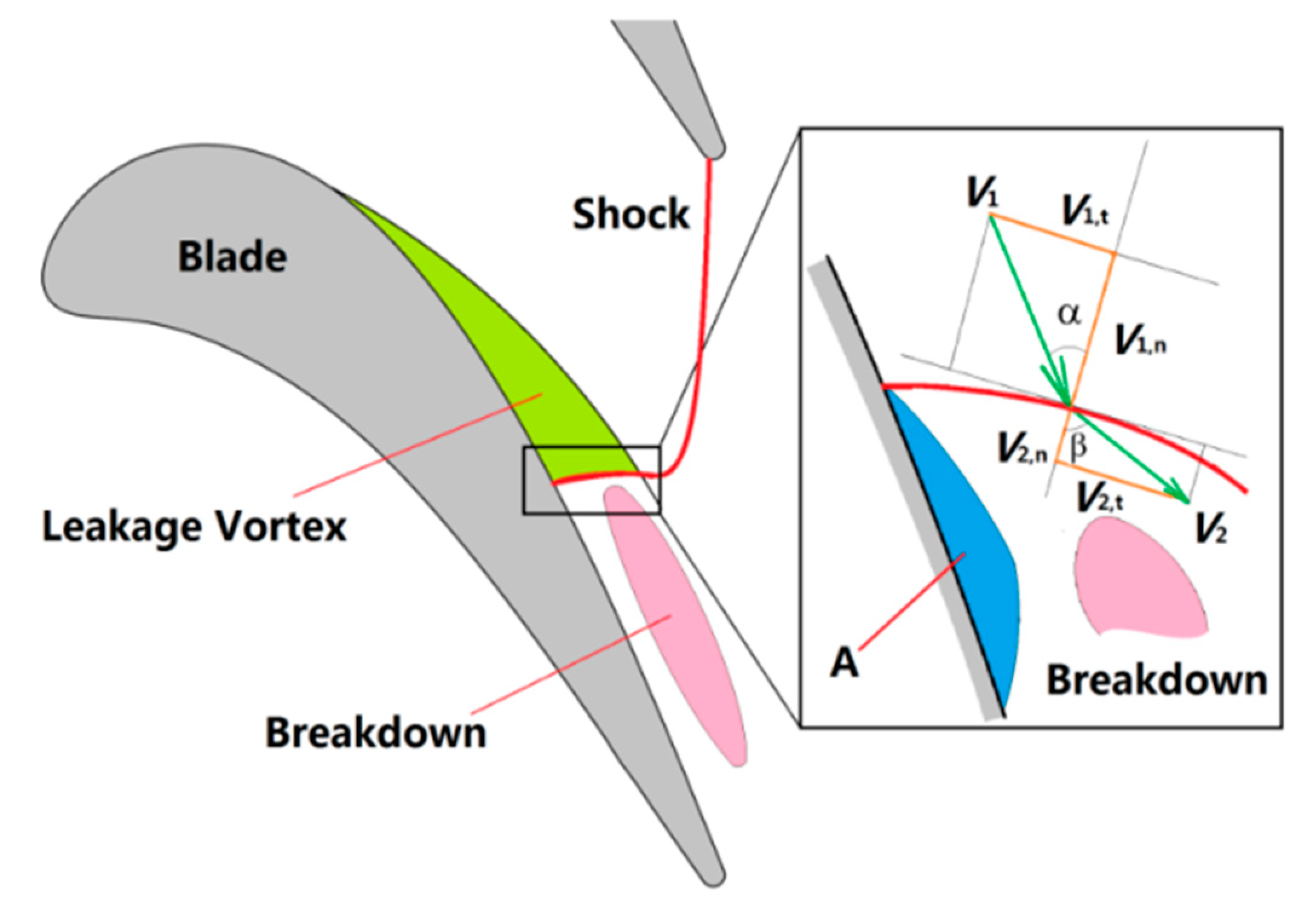
| Parameter | Value | |
|---|---|---|
| Absolute Total Pressure/kPa | 1210.13 | |
| Absolute Total Temperature/K | 1588 | |
| Incoming Flow Angle/deg | Hub | 73.1 |
| Mean | 74.2 | |
| Shroud | 75.4 | |
| Incoming Turbulence Intensity/% | 10 | |
| Rotating Speed/RPM | 12,630 |
Publisher’s Note: MDPI stays neutral with regard to jurisdictional claims in published maps and institutional affiliations. |
© 2021 by the authors. Licensee MDPI, Basel, Switzerland. This article is an open access article distributed under the terms and conditions of the Creative Commons Attribution (CC BY) license (https://creativecommons.org/licenses/by/4.0/).
Share and Cite
Wei, Z.; Ren, G.; Gan, X.; Ni, M.; Chen, W. Influence of Shock Wave on Loss and Breakdown of Tip-Leakage Vortex in Turbine Rotor with Varying Backpressure. Appl. Sci. 2021, 11, 4991. https://doi.org/10.3390/app11114991
Wei Z, Ren G, Gan X, Ni M, Chen W. Influence of Shock Wave on Loss and Breakdown of Tip-Leakage Vortex in Turbine Rotor with Varying Backpressure. Applied Sciences. 2021; 11(11):4991. https://doi.org/10.3390/app11114991
Chicago/Turabian StyleWei, Zuojun, Guangming Ren, Xiaohua Gan, Ming Ni, and Weijie Chen. 2021. "Influence of Shock Wave on Loss and Breakdown of Tip-Leakage Vortex in Turbine Rotor with Varying Backpressure" Applied Sciences 11, no. 11: 4991. https://doi.org/10.3390/app11114991






